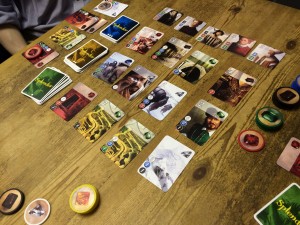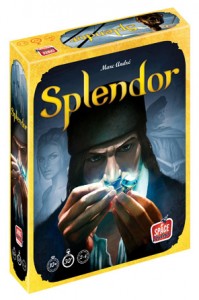Review: Splendor
Posted by James (admin) on May 22nd, 2014
 Splendor is a light, fast game of constant, small decisions. Overall, it’s a race to be the first player to score 15 Victory Points (VPs) by buying development cards using the 5 different coloured currencies (gems).
Splendor is a light, fast game of constant, small decisions. Overall, it’s a race to be the first player to score 15 Victory Points (VPs) by buying development cards using the 5 different coloured currencies (gems).
Each development card is a colour and each card shows its cost as well as how many VPs it is worth. Each card you purchase gives a permanent reduction on your future purchases; for example, a card costing 2 red gems and 3 green gems would only cost 2 red and 1 green if a player had already bought 2 green cards. As a result, players’ purchasing power increases as the game unfolds.
The game mechanic of discounting future purchases means that every card you buy is potentially useful and means each player has a slightly different view of the game because the costs of the cards on display become different for each player. Also, whilst gaining VPs is slow to start, with as players purchase the cheap (bottom row) cards usually worth no VPs, the game accelerates as players’ purchasing power increases and they can more regularly buy the expensive (top row) cards worth higher amounts of VPs. (Players can also score VPs by gaining noble tiles which are awarded as soon as a player has bought enough different coloured cards as shown on the tiles.)
On their turn, a player can do one action: (a) Take 3 different coloured coins from the bank, (b) Take 2 coins of the same colour from the bank (so long as 2 coins of that colour remain), (c) Build a card from the display or their hand by paying the cost, or (d) Take a card from the display into their hand (3 max) and take 1 gold coin (which counts as any colour).
As turns are short and simple, the game moves quickly, plus the frequent purchasing of cards means the cards in the display are constantly changing. Often, a card you want will be taken before you can buy it, so you need to quickly think what your new plan will be.
It’s important to note that the coins of each colour are limited and in short supply (for example, there are only 7 coins of each colour with 5 players) and it is this limited currency that adds lots of tension and makes you feel constantly torn between using your turn to take coins or to take a card (whether to build now or later). Even the choice between taking 2 coins of 1 colour versus 3 different colour coins can be a tricky decision (plus you need to decide which colour(s) do you take). There is a limit to the coins a player can hold so you can’t hoover up the entire bank; however, a player can try to horde one colour to make it difficult for other players (although it leaves them with little room for coins to spend themselves).
There is some luck in the order, and combination, in which the cards are drawn; for example, there may not be cards on display on which you can use your discounts to their full potential. Also, one player may have built cards that match the cost of several cards that happen to be on display (i.e. the player has 4 blue buildings and there are 2 cards with high blue costs so that player can buy those easily). However, this doesn’t really become an issue because the cards on display change quickly. Also, it just means you need to decide whether to wait for what you want or to change plan and react to what’s on display.
If the cards on display do favour an opponent because they fit what they have built, you can stop them from getting these easy gains by taking the card they could easily buy into your own hand, so there’s scope for denial in this game. The 3-card hand limit works really well to ensure players can not deny others forever, but also each card you take to deny someone else takes up valuable space in your hand too. I think it’s hard to keep track of what other players may be wanting to buy/take/do as their cards/coins (and the cards on display) change rapidly; however, I think this watching of opponents, and denying them, is an area of the game that experienced players will start to develop more and more to get the edge on their opponents.
The components are very good with heavy poker-chip-style pieces for the coins which make them very tactile. Also, the box insert is bespoke to fit all the coins and cards into their own slots – an aspect I always appreciate. The gameplay and theme aren’t really directly connected, but the artwork does a good job of making it feel cohesive, especially with the nice progression to the artwork across the 3 tiers of cards showing the source, transport and destination of the different coloured gems.
As far as downsides are concerned – well, there aren’t any serious ones. There is a lot of information to track as it’s a fast-moving game which sometimes means it can take a moment to work out what the costs of the cards are to you (once you’ve subtracted the cards you’ve already built). I found it helps if you lay out your coins above the matching colour column of cards you’ve built (i.e. blue coins above blue cards) so you can quickly add up your total buying power. (An app of Splendor would be very fast to play as it could automatically make any deductions plus highlight what you could buy.)
For me, I’m not sure the costs on the cards visually jump out immediately because the colours are often similar to the colour pallette of the pictures behind them, plus the number covers up some of the colour. I would have liked if the costs were a bit bigger, or maybe had a coloured area behind them (i.e. down the side of the cards) to help the costs stand out. However, this isn’t a major issue and I became more used to it as I played.
The gameplay may be quite similar if played a lot but, as I usually say when considering games like this, I don’t mind this when it’s a simple, fast game. (As the game is so streamlined, I can imagine there could even be an expansion to add one extra mechanic to add more depth and/or variety.)
Overall, I really enjoyed Splendor – it’s a fast game of constant, simple decisions. There’s a constant feel of being a race to the finish, and you’re always nervous someone’s about to mess up your next action(s) by taking the card or coins you need. As a result, it’s a fun, longer-filler for gamers and it’s a game for lighter/newer/younger gamers too.
Splendor has been nominated for the Spiel des Jahres 2014. You can see the full list of nominations with links to reviews on the SdJ 2014 page.
James.
[Played with 3 and 4 players]


